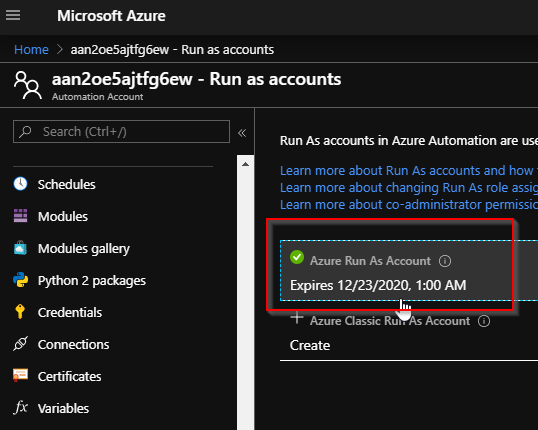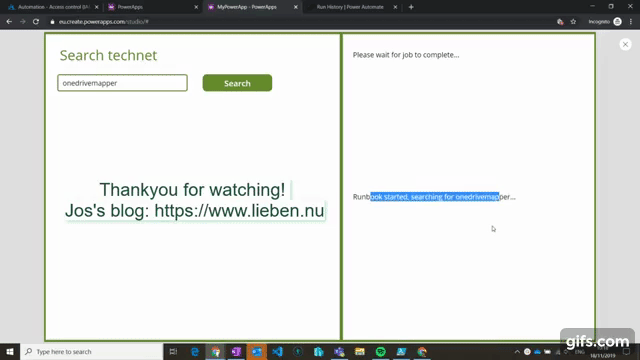
The Graph and other Microsoft API’s should be called using a Service Principal whenever possible. But some endpoints (such as the ‘hidden’ azure api) don’t support service principals and require an actual user to call it.
Of course, users that have privileges in your organisation are protected with MFA / conditional access or you wouldn’t be reading my blog 🙂
Below script circumvents MFA by hijacking a refresh token which normally isn’t returned/exposed to the user. It then encrypts and caches it locally and refreshes and reuses it the next time it is called. As refresh tokens expire after 90 days of inactivity by default, you won’t see an MFA prompt again as long as the script runs at least once every 90 days.
Requirements:
Az.Accounts module- User account
- Onetime MFA prompt completion
Method 1: Code at Gitlab (requires Az.Accounts module)
Method 2: Code at GitLab (does not require any modules)
Method 1 example:
<#
.SYNOPSIS
Retrieve graph or other azure tokens as desired (e.g. for https://main.iam.ad.ext.azure.com) and bypass MFA by repeatedly recaching the RefreshToken stolen from the TokenCache of the Az module.
Only the first login will require an interactive login, subsequent logins will not require interactivity and will bypass MFA.
This script is without warranty and not for commercial use without prior consent from the author. It is meant for scenario's where you need an Azure token to automate something that cannot yet be done with service principals.
If your refresh token expires (default 90 days of inactivity) you'll have to rerun the script interactively.
.EXAMPLE
$graphToken = get-azResourceTokenSilently -userUPN nobody@lieben.nu
.PARAMETER userUPN
the UPN of the user you need a token for (that is MFA enabled or protected by a CA policy)
.PARAMETER refreshTokenCachePath
Path to encrypted token cache if you don't want to use the default
.PARAMETER tenantId
If supplied, logs in to specified tenant, optional and only required if you're using Azure B2B
.PARAMETER resource
Resource your token is for, e.g. "https://graph.microsoft.com" would give a token for the Graph API
.PARAMETER refreshToken
If supplied, this is used to update the token cache and interactive login will not be required. This parameter is meant as an alternative to that initial first time interactive login
.NOTES
filename: get-azResourceTokenSilently.ps1
author: Jos Lieben
blog: www.lieben.nu
created: 09/04/2020
#>
Param(
$refreshTokenCachePath=(Join-Path $env:APPDATA -ChildPath "azRfTknCache.cf"),
$refreshToken,
$tenantId,
[Parameter(Mandatory=$true)]$userUPN,
$resource="https://graph.microsoft.com"
)
$strCurrentTimeZone = (Get-WmiObject win32_timezone).StandardName
$TZ = [System.TimeZoneInfo]::FindSystemTimeZoneById($strCurrentTimeZone)
[datetime]$origin = '1970-01-01 00:00:00'
if(!$tenantId){
$tenantId = (Invoke-RestMethod "https://login.windows.net/$($userUPN.Split("@")[1])/.well-known/openid-configuration" -Method GET).userinfo_endpoint.Split("/")[3]
}
if($refreshToken){
try{
write-verbose "checking provided refresh token and updating it"
$response = (Invoke-RestMethod "https://login.windows.net/$tenantId/oauth2/token" -Method POST -Body "grant_type=refresh_token&refresh_token=$refreshToken" -ErrorAction Stop)
$refreshToken = $response.refresh_token
$AccessToken = $response.access_token
write-verbose "refresh and access token updated"
}catch{
Write-Output "Failed to use cached refresh token, need interactive login or token from cache"
$refreshToken = $False
}
}
if([System.IO.File]::Exists($refreshTokenCachePath) -and !$refreshToken){
try{
write-verbose "getting refresh token from cache"
$refreshToken = Get-Content $refreshTokenCachePath -ErrorAction Stop | ConvertTo-SecureString -ErrorAction Stop
$refreshToken = [System.Runtime.InteropServices.Marshal]::SecureStringToBSTR($refreshToken)
$refreshToken = [System.Runtime.InteropServices.Marshal]::PtrToStringAuto($refreshToken)
$response = (Invoke-RestMethod "https://login.windows.net/$tenantId/oauth2/token" -Method POST -Body "grant_type=refresh_token&refresh_token=$refreshToken" -ErrorAction Stop)
$refreshToken = $response.refresh_token
$AccessToken = $response.access_token
write-verbose "tokens updated using cached token"
}catch{
Write-Output "Failed to use cached refresh token, need interactive login"
$refreshToken = $False
}
}
#full login required
if(!$refreshToken){
Write-Verbose "No cache file exists and no refresh token supplied, perform interactive logon"
if ([Environment]::UserInteractive) {
foreach ($arg in [Environment]::GetCommandLineArgs()) {
if ($arg -like '-NonI*') {
Throw "Interactive login required, but script is not running interactively. Run once interactively or supply a refresh token with -refreshToken"
}
}
}
Import-Module az.accounts -erroraction silentlycontinue | out-null
if(!(Get-Module -Name "Az.Accounts")){
Throw "Az.Accounts module not installed!"
}
Write-Verbose "Calling Login-AzAccount"
if($tenantId){
$Null = Login-AzAccount -Tenant $tenantId -ErrorAction Stop
}else{
$Null = Login-AzAccount -ErrorAction Stop
}
#if login worked, we should have a Context
$context = [Microsoft.Azure.Commands.Common.Authentication.Abstractions.AzureRmProfileProvider]::Instance.Profile.DefaultContext
if($context){
Write-verbose "logged in, checking local refresh tokens..."
$string = [System.Text.Encoding]::Default.GetString($context.TokenCache.CacheData)
$marker = 0
$tokens = @()
while($true){
$marker = $string.IndexOf("https://",$marker)
if($marker -eq -1){break}
$uri = $string.SubString($marker,$string.IndexOf("RefreshToken",$marker)-4-$marker)
$marker = $string.IndexOf("RefreshToken",$marker)+15
if($string.Substring($marker+2,4) -ne "null"){
$refreshtoken = $string.SubString($marker,$string.IndexOf("ResourceInResponse",$marker)-3-$marker)
$marker = $string.IndexOf("ExpiresOn",$marker)+31
$expirydate = $string.SubString($marker,$string.IndexOf("OffsetMinutes",$marker)-6-$marker)
$tokens += [PSCustomObject]@{"expiresOn"=[System.TimeZoneInfo]::ConvertTimeFromUtc($origin.AddMilliseconds($expirydate), $TZ);"refreshToken"=$refreshToken;"target"=$uri}
}
}
$refreshToken = @($tokens | Where-Object {$_.expiresOn -gt (get-Date)} | Sort-Object -Descending -Property expiresOn)[0].refreshToken
write-verbose "updating stolen refresh token"
$response = (Invoke-RestMethod "https://login.windows.net/$tenantId/oauth2/token" -Method POST -Body "grant_type=refresh_token&refresh_token=$refreshToken" -ErrorAction Stop)
$refreshToken = $response.refresh_token
$AccessToken = $response.access_token
write-verbose "tokens updated"
}else{
Throw "Login-AzAccount failed, cannot continue"
}
}
if($refreshToken){
write-verbose "caching refresh token"
Set-Content -Path $refreshTokenCachePath -Value ($refreshToken | ConvertTo-SecureString -AsPlainText -Force -ErrorAction Stop | ConvertFrom-SecureString -ErrorAction Stop) -Force -ErrorAction Continue | Out-Null
write-verbose "refresh token cached"
}else{
Throw "No refresh token found in cache and no valid refresh token passed or received after login, cannot continue"
}
if($AccessToken){
write-verbose "update token for supplied resource"
$null = Login-AzAccount -AccountId $userUPN -AccessToken $AccessToken
$context = [Microsoft.Azure.Commands.Common.Authentication.Abstractions.AzureRmProfileProvider]::Instance.Profile.DefaultContext
$resourceToken = [Microsoft.Azure.Commands.Common.Authentication.AzureSession]::Instance.AuthenticationFactory.Authenticate($context.Account, $context.Environment, $context.Tenant.Id.ToString(), $null, [Microsoft.Azure.Commands.Common.Authentication.ShowDialog]::Never, $null, $resource).AccessToken
}else{
Throw "Failed to translate access token to $resource , cannot continue"
}
return $resourceToken
This post was inspired by a use case Mark had for Senserva.com


